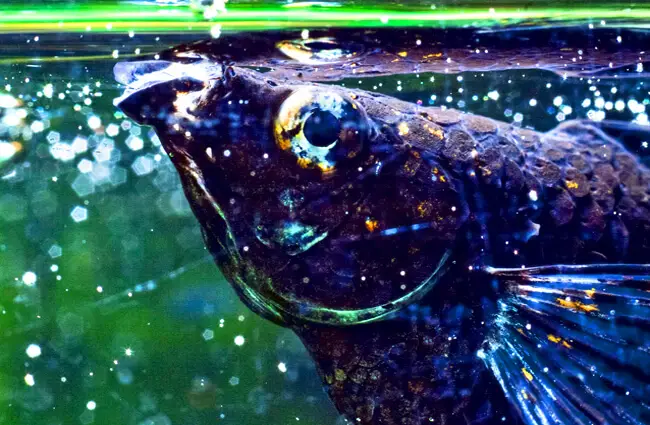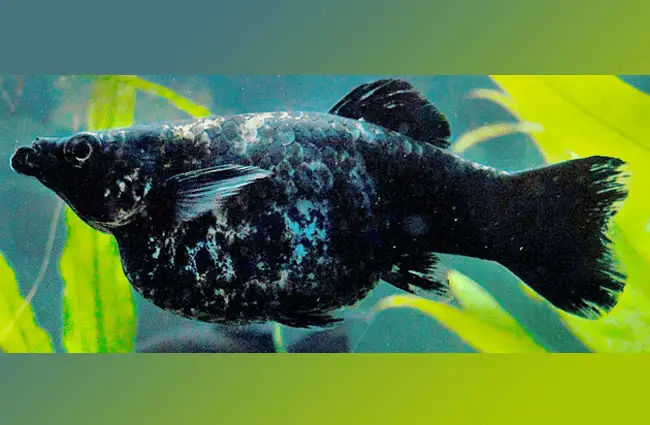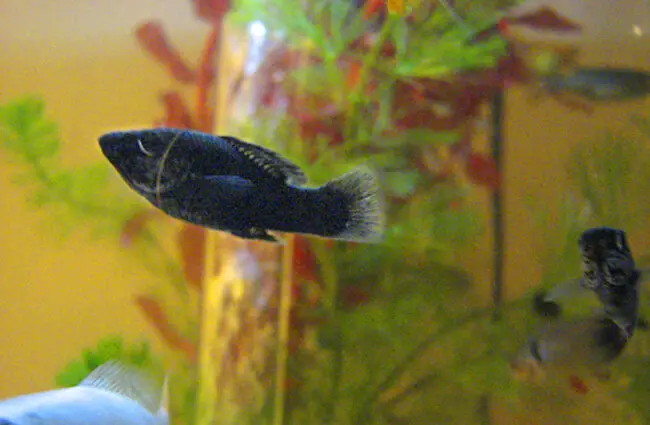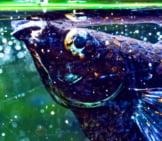The Black Molly is a small, dark colored fish in the Poeciliidae family. Other members of the family include other mollies, swordtails, platys, and more. People created this particular fish through the cross breeding, or hybridization, of the Common Molly and the Sailfin Molly. Read on to learn about the Black Molly.
Description of the Black Molly
This small fish lives up to its name. Its entire body, from its scales to its tail to its fins, is entirely black. Additionally, its scales have flat coloration without iridescent shine. Most individuals have fins with a rounded shape. Typically, these fish measure between three and six inches in length.
Interesting Facts About the Black Molly
These fish have a unique appearance and a unique background. Learn more about them, below.
- Freshwater Fish? – It may surprise you, but though people often keep this fish in freshwater environments, it actually thrives in tanks with partial saltwater. These fish prefer brackish water tanks over pure freshwater.
- Melanistic – These fish get their color from melanism. This is basically the opposite of albino. The animals develop an abnormal amount of melanin, giving them a darker coloration.
- Tip-Top Tank – Though they are small, these fish need large tanks and well-cleaned water. You must provide at least 20 gallons for them, and 45 gallons is preferable.
Habitat of the Black Molly
Because humans created this hybrid, they do not have a “natural” habitat. However, the two species that people use to breed them occupy several different types of habitats. They live in fresh, salt, and brackish habitats. Some common ecosystem preferences include streams, small pools, wetlands, swamps, and coastal areas.
Distribution of the Black Molly
As discussed above, this fish does not have a natural population. Because of this, their distribution comes primarily from human activity. They live in household aquariums virtually throughout the globe.
Diet of the Black Molly
People most frequently feed this molly commercially produced fish food. They are omnivorous, so their diet contains a wide variety of foods, including algae, detritus, and just about anything you feed them. You can also provide fresh veggies, such as cucumbers, zucchini, and more.
Black Molly and Human Interaction
These fish exist only through human activity. People cross breeding the Common and Sailfin mollies created this hybrid. Thus, humans interact with these fish incredibly frequently. They are common in household aquariums.
Domestication
Humans have not fully domesticated this species.
Does the Black Molly Make a Good Pet
Yes, this fish makes a good pet. However, they are not a great fit for beginners because they have slightly higher water quality standards than some other fish.
Black Molly Care
You should keep this fish in a 20 – 45 gallon aquarium, the larger the better. Their water temperature should remain between 70 and 80 degrees Fahrenheit. They are sensitive to change in their water, so you should keep the temperature and pH as consistent as possible. The optimal pH range is between 7.5 and 8.2 or so.
Behavior of the Black Molly
Though this fish doesn’t have wild populations, it does prefer social environments. It lives in groups known as schools. The schools swim along in the water in search of anything edible to eat. Though most are placid, males can be quite aggressive towards one another and sometimes towards females.
Reproduction of the Black Molly
Males establish breeding territories. Females choose the most suitable mate, who fertilizes her eggs internally. She develops the eggs for about a month before giving “live” birth to the young, known as fry. You should provide a wide variety of plants and other shelter for the fry to avoid cannibalism by the adults.









![Red Angus Closeup of a beautiful Red Angus cowPhoto by: U.S. Department of Agriculture [pubic domain]https://creativecommons.org/licenses/by/2.0/](https://animals.net/wp-content/uploads/2020/03/Red-Angus-4-238x178.jpg)












![Red Angus Closeup of a beautiful Red Angus cowPhoto by: U.S. Department of Agriculture [pubic domain]https://creativecommons.org/licenses/by/2.0/](https://animals.net/wp-content/uploads/2020/03/Red-Angus-4-100x75.jpg)

